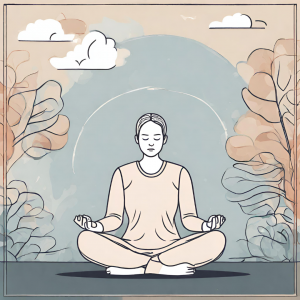Best Breathing Exercises to Reduce Stress: Expert Recommendations

Breathing exercises are an effective way to reduce stress and anxiety, and promote relaxation and comfort. When you are feeling stressed or overwhelmed, taking a few minutes to focus on your breath can help you feel more calm and centered. By controlling your breathing, you can slow down your heart rate, lower your blood pressure, and activate your body’s relaxation response.
Understanding the connection between breathing and stress is key to using breathing exercises effectively. Stress can cause shallow, rapid breathing, which can further increase feelings of anxiety and tension. Conversely, deep breathing can help to slow down your heart rate and reduce the symptoms of stress. By practicing deep breathing techniques regularly, you can learn to control your breathing and reduce the impact of stress on your body and mind.
There are many effective breathing exercises that you can incorporate into your daily routine. From simple techniques like counting your breaths or practicing deep breathing, to more advanced exercises like alternate nostril breathing or box breathing, there are many options to choose from. By experimenting with different techniques and finding what works best for you, you can develop a regular breathing practice that helps you to manage stress and improve your overall health and well-being.
Key Takeaways
- Breathing exercises can help to reduce stress and anxiety, promote relaxation, and improve overall well-being.
- Understanding the connection between breathing and stress is key to using breathing exercises effectively.
- There are many effective breathing exercises to choose from, and by experimenting with different techniques you can develop a regular practice that works for you.
Understanding Breathing and Stress
Breathing is an essential part of life, but did you know that it can also impact your stress levels? When you experience stress, your sympathetic nervous system is activated, which causes shallow and rapid breathing. This type of breathing can lead to an increase in heart rate, blood pressure, and muscle tension.
On the other hand, when you breathe deeply using your diaphragm, you activate your parasympathetic nervous system. This type of breathing can help reduce stress by slowing down your heart rate, lowering your blood pressure, and reducing muscle tension.
One effective breathing exercise is alternate nostril breathing, also known as nadi shodhana. This exercise involves breathing in through one nostril and out through the other, which can help balance the left and right sides of your brain and promote relaxation.
Another effective breathing exercise is lion’s breath, which involves inhaling deeply through your nose and exhaling forcefully through your mouth while sticking out your tongue. This exercise can help release tension in your face and throat and promote relaxation.
Coherent breathing is another effective technique that involves breathing at a rate of five breaths per minute. This technique has been shown to improve heart rate variability and reduce fatigue.
Equal breathing, also known as samavritti pranayama, involves inhaling and exhaling for an equal amount of time. This technique can help reduce stress and promote relaxation.
If you suffer from chronic obstructive pulmonary disease (COPD), pursed-lip breathing can be an effective technique to help you breathe more efficiently and reduce shortness of breath.
In conclusion, incorporating simple breathing exercises into your daily routine can help reduce stress and promote relaxation. By understanding how breathing impacts your stress levels, you can take control of your breathing and improve your overall well-being.
Effective Breathing Exercises
When it comes to reducing stress, breathing exercises can be a powerful tool. Here are some of the most effective breathing techniques to help you calm your mind and relax.
Deep Breathing Techniques
Deep breathing techniques, also known as diaphragmatic or belly breathing, involve taking slow, deep breaths that expand your belly and diaphragm. To do this, you can lie down, sit in a chair or on a bed, or stand with your knees slightly bent. Place one hand on your belly and one hand on your chest. Take a slow, deep breath in through your nose, feeling your belly rise. Hold for a few seconds, then exhale slowly through your mouth, feeling your belly fall. Repeat for 5 minutes.
4-7-8 Breathing
4-7-8 breathing is a simple breathing exercise that can help you relax and fall asleep faster. To do this, sit in a chair with your back straight. Place the tip of your tongue behind your upper front teeth. Exhale completely through your mouth, making a whooshing sound. Close your mouth and inhale through your nose for a count of 4. Hold your breath for a count of 7. Exhale through your mouth for a count of 8, making a whooshing sound. Repeat for 4 cycles.
Box Breathing
Box breathing is a technique used by Navy SEALs to calm their minds and reduce stress. To do this, sit in a chair with your back straight. Inhale through your nose for a count of 4. Hold your breath for a count of 4. Exhale through your mouth for a count of 4. Hold your breath for a count of 4. Repeat for 5 minutes.
Belly Breathing
Belly breathing, also known as abdominal breathing, is a simple breathing exercise that can help you relax and reduce stress. To do this, lie down on your back with your knees bent or sit in a chair with your back straight. Place one hand on your belly and one hand on your chest. Take a slow, deep breath in through your nose, feeling your belly rise. Hold for a few seconds, then exhale slowly through your mouth, feeling your belly fall. Repeat for 5 minutes.
Alternate Nostril Breathing
Alternate nostril breathing, also known as nadi shodhana, is a yoga breathing exercise that can help you relax and reduce stress. To do this, sit in a chair with your back straight. Place your left hand on your left knee and bring your right hand to your nose. Use your right thumb to close your right nostril and inhale through your left nostril. Hold your breath for a few seconds, then use your right ring finger to close your left nostril and exhale through your right nostril. Inhale through your right nostril, hold your breath, then exhale through your left nostril. Repeat for 5 minutes.
By practicing these breathing exercises regularly, you can activate the relaxation response, reduce blood pressure, and increase feelings of calm and well-being. Try incorporating these simple breathing exercises into your daily routine to help reduce stress and improve your overall health.
Incorporating Breathing Exercises into Daily Routine
If you’re looking to reduce stress, incorporating breathing exercises into your daily routine can be a simple and effective way to achieve that goal. Here are some tips on how to make breathing exercises a part of your daily routine:
1. Find a time that works for you
Choose a time of day that works best for you to practice your breathing exercises. It could be first thing in the morning, during your lunch break, or before bed. Whatever time you choose, make sure it’s a time when you can focus on your breathing without any distractions.
2. Create a relaxing environment
Find a quiet and comfortable place to practice your breathing exercises. Wear comfortable clothes that won’t restrict your breathing, and remove any distractions such as your phone or computer.
3. Choose the right breathing exercise
There are many different breathing exercises to choose from, so find one that works best for you. Some popular breathing exercises include diaphragmatic breathing, box breathing, and alternate nostril breathing.
4. Practice mindfulness
Mindfulness is the practice of being present in the moment. When practicing your breathing exercises, focus on your breath and try to clear your mind of any distractions. Counting your breaths or visualizing a calming scene can also help you stay focused.
5. Incorporate breathing exercises into daily activities
You don’t have to set aside a specific time to practice your breathing exercises. You can incorporate them into your daily activities, such as during your commute or while doing household chores. Just remember to stay mindful and focused on your breath.
By incorporating breathing exercises into your daily routine, you can relieve stress and improve your overall well-being. With a little practice and dedication, you can make breathing exercises a habit that will benefit you for years to come.
Frequently Asked Questions
What are some effective breathing exercises to reduce stress?
There are many effective breathing exercises that can help reduce stress. Some of the most popular ones include deep breathing, diaphragmatic breathing, box breathing, and alternate nostril breathing. These exercises can help calm the mind, slow the heart rate, and reduce feelings of anxiety.
What is the 4-7-8 breathing method and how does it help with stress?
The 4-7-8 breathing method is a technique that involves breathing in for 4 seconds, holding the breath for 7 seconds, and exhaling for 8 seconds. This method helps to slow down the heart rate and calm the mind, making it an effective way to reduce stress and anxiety.
How can deep breathing benefit my mental health?
Deep breathing can benefit your mental health in a number of ways. By slowing down your breathing and focusing on your breath, you can reduce feelings of anxiety and stress. Deep breathing can also help you feel more relaxed and centered, which can improve your overall sense of well-being.
What are some quick relaxation techniques for anxiety?
If you’re feeling anxious and need to relax quickly, there are a few techniques you can try. One effective method is to take slow, deep breaths. You can also try progressive muscle relaxation, where you tense and then relax each muscle group in your body. Another technique is to visualize a peaceful scene or repeat a calming phrase to yourself.
Are there any dangers associated with deep breathing exercises?
Deep breathing exercises are generally safe for most people. However, if you have a history of respiratory problems, such as asthma or COPD, you should talk to your doctor before starting any new breathing exercises. Additionally, if you experience any discomfort or dizziness while practicing deep breathing, you should stop and seek medical attention.
How does practicing box breathing help with stress and anxiety?
Box breathing is a technique that involves breathing in for 4 seconds, holding the breath for 4 seconds, exhaling for 4 seconds, and holding the breath for 4 seconds before repeating the cycle. This method can help to slow down the heart rate and reduce feelings of anxiety and stress. By focusing on your breath and the counting, you can also distract your mind from any negative thoughts or worries.
